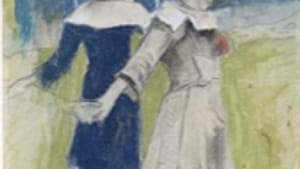Stay in the Loop
BSR publishes on a weekly schedule, with an email newsletter every Wednesday and Thursday morning. There’s no paywall, and subscribing is always free.
The line does not lie: A double feast of drawings in New York
Drawings in New York: Thaw and Bonna Collections

The line does not lie. You can fudge many things in art, as in life, but drawing is the truth. I'm not talking about accurate representation; I mean the leap that imagination makes through the hand to catch the essence of life.
Almost all nonperformance art traverses that route, of course. But in drawing, it is direct and unmediated except through the medium that conveys the will of the hand to the surface that receives it. In drawing, every mistake is indelible; every triumph is immediate.
The respective exhibits of recent acquisitions in the Eugene V. Thaw collection at the Morgan Library and the Jean Bonna collection at the Metropolitan Museum of Art have few flaws indeed, and a great many triumphs. The Donna features additions to one of the world's superb drawing collections over the past 20 years; the Thaw, proportionally smaller, from only the last seven.
The usual (and unusual) suspects
The Thaw, in addition to many of the usual suspects— from a splendid chalk profile of a bearded man by the 16th-Century master Federico Barocci to a Jim Dine from 2000— also features such lesser-knowns as the Dutchmen Willem Buytenwech and Jan Asselijn and the Germans Johann Georg von Dillis and Josephus Augustus Knip, the latter represented by a ruined Temple of Minerva whose dome suggests the contour of a human skull (and is the only surviving representation of it, since it collapsed a few years later).
One might interestingly compare the Knip with Jacques Villon's Study of a Skull (1956-58), done in the artist's own 80s, or note the influence of Jackson Pollock on a slightly later David Smith. There's a rare Degas landscape, Odilon Redon's takeoff on an 18th-Century French genre, Centaur Reading, and a splendid Study for Breton Girls Dancing by Gauguin (above). One is obliged to note too a fair amount of academic work in a 19th-Century pseudo-Renaissance style, drearily accomplished but quite lacking in life. Much is forgiven, however, for Matisse's stunning late-period study of his model, Lydia Delectorskaya, Grand Visage I, a work executed with fewer than 20 brushstrokes.
Bonna's greater consistency
The Bonna collection is not only larger but also more consistent in quality. Its great prize is a Raphael in chalks, depicting three figures, one astride an unarticulated horse, in motion toward the right. Like most Renaissance drawings, it's a preliminary sketch for a painting or other large-scale work, but its very "incompletion"— the absence of the scene or object toward which the figures turn, the absence of the horse beneath the rider— is what gives the work its paradoxical quality, at once as static and monumental as a Greek frieze, yet also pulsing and vivid, as if time itself were arrested in flight.
Raphael couldn't have consciously intended this effect, which indeed no finished drawing could achieve. He probably sketched until he was satisfied that he was getting the effect he sought for a larger composition, and left this casual masterpiece to fare as it would. To be sure, if he more than glanced at it, he would have recognized its quality; but genius can afford to be profligate.
Good— let alone great— Renaissance drawings seldom come on the market, but there's a fine Carpaccio in the Bonna haul, a Parmigianino, and a quite magnificent Barocci, the head of a young woman in pastels and black chalk that has the somber address of an unsmiling Mona Lisa. To this image might be contrasted the melancholy but no less lovely face of the Baroque artist Jacopo Vignali's Head of a Young Woman, a rare portrait of genuine, inward sadness unattached to any conventional scene of grief.
Inclusion by omission
Things cheer up considerably in the 18th Century with fine studies of young women by Boucher, Chardin and Greuze, although there is Watteau, too, in whose poised and delicate figures, so wondrously alive, is always the tincture of mortality.
The 19th Century (Bonna's stopping point) is largely devoted to French masters, though there's a curiously haunting Burne-Jones, who's usually dismissed as a mooning pre-Raphaelite, and a sensitive Whistler. Ingres, Gericault and Delacroix are represented from the earlier part of the century. But the climax of the show (if the Raphael isn't both its beginning and climax) is in splendid works by Degas (particularly his Head of a Woman with a Seated Dancer), Cézanne (a spare Wooded Landscape that is, even more than the Raphael, a pure example of inclusion-by-omission), Gauguin's superbly vigorous Two Tahitian Women (the first in bold outline, the second a shadowy, anima-like presence in an uncertain space), and Odilon Redon's La Barque, with its mysterious raised sail that seems, somehow, to contain a shark's fin in it.
Renoir has the last word, at least chronologically (born before Gauguin, he died in 1919), with a lovely tumble of nudes. For those of us who lack the ultra-billions required to amass a personal collection of the masters of this size and quality, one can only salute Monsieur Bonna for his good taste, ample fortune and willingness to share. ïµ
Almost all nonperformance art traverses that route, of course. But in drawing, it is direct and unmediated except through the medium that conveys the will of the hand to the surface that receives it. In drawing, every mistake is indelible; every triumph is immediate.
The respective exhibits of recent acquisitions in the Eugene V. Thaw collection at the Morgan Library and the Jean Bonna collection at the Metropolitan Museum of Art have few flaws indeed, and a great many triumphs. The Donna features additions to one of the world's superb drawing collections over the past 20 years; the Thaw, proportionally smaller, from only the last seven.
The usual (and unusual) suspects
The Thaw, in addition to many of the usual suspects— from a splendid chalk profile of a bearded man by the 16th-Century master Federico Barocci to a Jim Dine from 2000— also features such lesser-knowns as the Dutchmen Willem Buytenwech and Jan Asselijn and the Germans Johann Georg von Dillis and Josephus Augustus Knip, the latter represented by a ruined Temple of Minerva whose dome suggests the contour of a human skull (and is the only surviving representation of it, since it collapsed a few years later).
One might interestingly compare the Knip with Jacques Villon's Study of a Skull (1956-58), done in the artist's own 80s, or note the influence of Jackson Pollock on a slightly later David Smith. There's a rare Degas landscape, Odilon Redon's takeoff on an 18th-Century French genre, Centaur Reading, and a splendid Study for Breton Girls Dancing by Gauguin (above). One is obliged to note too a fair amount of academic work in a 19th-Century pseudo-Renaissance style, drearily accomplished but quite lacking in life. Much is forgiven, however, for Matisse's stunning late-period study of his model, Lydia Delectorskaya, Grand Visage I, a work executed with fewer than 20 brushstrokes.
Bonna's greater consistency
The Bonna collection is not only larger but also more consistent in quality. Its great prize is a Raphael in chalks, depicting three figures, one astride an unarticulated horse, in motion toward the right. Like most Renaissance drawings, it's a preliminary sketch for a painting or other large-scale work, but its very "incompletion"— the absence of the scene or object toward which the figures turn, the absence of the horse beneath the rider— is what gives the work its paradoxical quality, at once as static and monumental as a Greek frieze, yet also pulsing and vivid, as if time itself were arrested in flight.
Raphael couldn't have consciously intended this effect, which indeed no finished drawing could achieve. He probably sketched until he was satisfied that he was getting the effect he sought for a larger composition, and left this casual masterpiece to fare as it would. To be sure, if he more than glanced at it, he would have recognized its quality; but genius can afford to be profligate.
Good— let alone great— Renaissance drawings seldom come on the market, but there's a fine Carpaccio in the Bonna haul, a Parmigianino, and a quite magnificent Barocci, the head of a young woman in pastels and black chalk that has the somber address of an unsmiling Mona Lisa. To this image might be contrasted the melancholy but no less lovely face of the Baroque artist Jacopo Vignali's Head of a Young Woman, a rare portrait of genuine, inward sadness unattached to any conventional scene of grief.
Inclusion by omission
Things cheer up considerably in the 18th Century with fine studies of young women by Boucher, Chardin and Greuze, although there is Watteau, too, in whose poised and delicate figures, so wondrously alive, is always the tincture of mortality.
The 19th Century (Bonna's stopping point) is largely devoted to French masters, though there's a curiously haunting Burne-Jones, who's usually dismissed as a mooning pre-Raphaelite, and a sensitive Whistler. Ingres, Gericault and Delacroix are represented from the earlier part of the century. But the climax of the show (if the Raphael isn't both its beginning and climax) is in splendid works by Degas (particularly his Head of a Woman with a Seated Dancer), Cézanne (a spare Wooded Landscape that is, even more than the Raphael, a pure example of inclusion-by-omission), Gauguin's superbly vigorous Two Tahitian Women (the first in bold outline, the second a shadowy, anima-like presence in an uncertain space), and Odilon Redon's La Barque, with its mysterious raised sail that seems, somehow, to contain a shark's fin in it.
Renoir has the last word, at least chronologically (born before Gauguin, he died in 1919), with a lovely tumble of nudes. For those of us who lack the ultra-billions required to amass a personal collection of the masters of this size and quality, one can only salute Monsieur Bonna for his good taste, ample fortune and willingness to share. ïµ
What, When, Where
“The Thaw Collection of Master Drawings: Acquisitions since 2002.†Through May 9, 2009 at the Morgan Library, 225 Madison Ave., New York. (212) 685-0008) or www.themorgan.org/exhibitions.
“From Raphael to Renoir: Drawings from the Collection of Jean Bonna.†Through April 26, 2009 at the Metropolitan Museum of Art, Fifth Avenue at 82nd St., New York. (212) 535-7710 or metmuseum.org.
Sign up for our newsletter
All of the week's new articles, all in one place. Sign up for the free weekly BSR newsletters, and don't miss a conversation.

 Robert Zaller
Robert Zaller